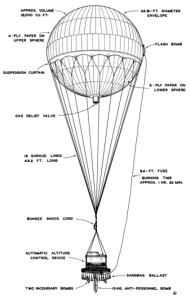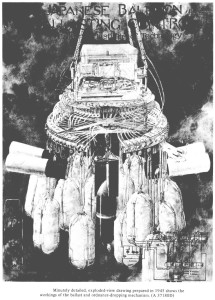On November 3, 1944, the Imperial Japanese Air Force launched an attack against North America that they hoped would help them win the war.
This was not an attack using aircraft carriers or even airplanes. It was not launched from submarines off the coast. Instead, from bases north of Tokyo, the Japanese launched more than 9000 hydrogen filled balloons, each carrying a 15 kg anti-personnel fragmentation bomb, two incendiary bombs, and a detonator designed to blow up the hydrogen that remained in the balloons upon landing..
It was an ingenious and fiendish idea from a country that was clearly running short of ingenious and fiendish ideas. To pull it off, they took advantage of their knowledge of the presence of the jet stream. Its odd to think about it now, but knowledge about the jet stream was incredibly limited prior to WW2. The Japanese had learned of these high speed winds that exist mostly above 25,000 ft. from experiments in the 1920’s where they launched balloons from a site near Mt. Fuji. They learned that the winds exist in bands that are as much as 200 km wide and 5 km in height. And the learned that they could launch a balloon into the jet stream from Japan and follow it all the way to North America.
No one in America paid much attention to what the Japanese were learning about the jet stream and it wasn’t until there were hundreds of Allied planes flying around at high altitudes during WW2 that knowledge about the jet stream became more common place. Pilots began to notice that at certain high altitudes, they were able to achieve far greater ground speeds when flying from west to east compared to when flying from east to west.
In the fall of 1944, the Imperial Japanese Air Force decided to take advantage of these winds to see if they could deliver bombs to North America using high altitude balloons. On November 3, 1944 they began to launch more than 9000 of these balloons hoping that they would drift over the large forests of Western Canada and the Western US. As they reached their destination the idea was that the explosives on the balloons would fire and hopefully ignite massive forest fires. They hoped that the fires would be so big that large numbers of soldiers would have to be drafted into the fight to extinguish the flames and that this would reduce the number of soldiers available to fight in the Pacific against Japan.
They built the balloons from a cloth-like paper called Mulberry Paper and filled them with hydrogen gas. The balloons were about 33 ft. in diameter and could lift 1000 lbs. To control the altitude of the balloons they were designed with an altimeter that would open a valve to release some hydrogen if the balloon rose above 38,000 ft. If the balloons began to drop below 30,000 ft., the altimeter would release ballast bags filled with sand. Each balloon had around 36 sand-filled ballast bags that were hung from an aluminum wheel that was suspended below the balloon. The bags were dropped in pairs, from opposite sides of the wheel, to keep the weight below the balloon centered so that the balloon would not be lopsided.
The idea was that the ballast bags and the hydrogen would be either released or dropped while the balloon floated to North America. They hoped that the winds would carry the balloons over the huge forests in the western parts of the continent and then descend to the ground. Hanging some 10 meters beneath each balloon was a fuse which ignited when it came into contact with something; in this case, hopefully the ground. The fuse would light and as the balloon made the last few feet of its descent, the fragmentation device, the incendiary devices, and the remaining hydrogen would explode and cause a massive forest fire.
It took a few days for the balloons to transit the Pacific Ocean and on November 5, they began arriving in North America. Of the 9000 balloons that were launched, there were confirmed sightings of about 300 of them. Balloons were spotted in Canada, as far east as Farmington, Michigan, just 10 miles from Detroit, and as far south as Neuvo Laredo in Mexico. Many of them functioned as designed and exploded, causing several fires. But the Japanese did not create the firestorm they had hoped for. The media was not allowed to mention a single word about the balloons as the government did not want to encourage the Japanese to send more. Furthermore, they did not want to alarm the general public so as to avoid any panic among the civilians who were suddenly being targeted directly from far off Japan.
The worst incident occurred in Oregon several months later in March of 1945. A women leading a church group on a fishing trip that included a number of kids came across one of the balloons hanging intact in a tree. Having no idea what it was, they pulled it down and were dragging it back to their camp when the fragmentation device exploded, killing the woman and five kids. After this incident, the Government allowed the media to warn the public to stay away from these balloons if they ever came across them.
But this is not quite the end of the story. Several balloons were found with ballast bags of sand still attached and the US Army set about trying to figure out their origin. As they examined the sand in the ballast bags under a microscope, it became more and more evident that the sand was quite unique. Geologists were called in to try to ascertain the exact origin of the sand. They found that the sand in the bags contained over 100 species of tiny fossils which indicated that the sand had come from a beach. They found no coral in the mix and they found small fragments of mollusks as well as microscopic skeletons of organisms that feed on the ocean bottom, called “forams”. Armed with this information, the geologists began to scour university libraries up and down the west coast of the US looking for any papers published in Japan on the geologic makeup of various Japanese beaches. Much to their surprise, they found a pre-war Japanese geological survey that described in great detail the beaches north of Tokyo on the eastern shore of the island of Honshu. The Japanese survey was so detailed that the geologists were able to narrow down the source of the sand as coming from the beaches around Sendai, about 350 km north of Tokyo.
Once this was done, the Air Force sent a number of reconnaissance flights over Sendai looking for a facility that might be used for the production of hydrogen. Sure enough…. They found it. In April of 1945, once identified, the Air Force sent a large number of bombers to Sendai to ensure that the no more balloon bombs would ever be sent to North America.


